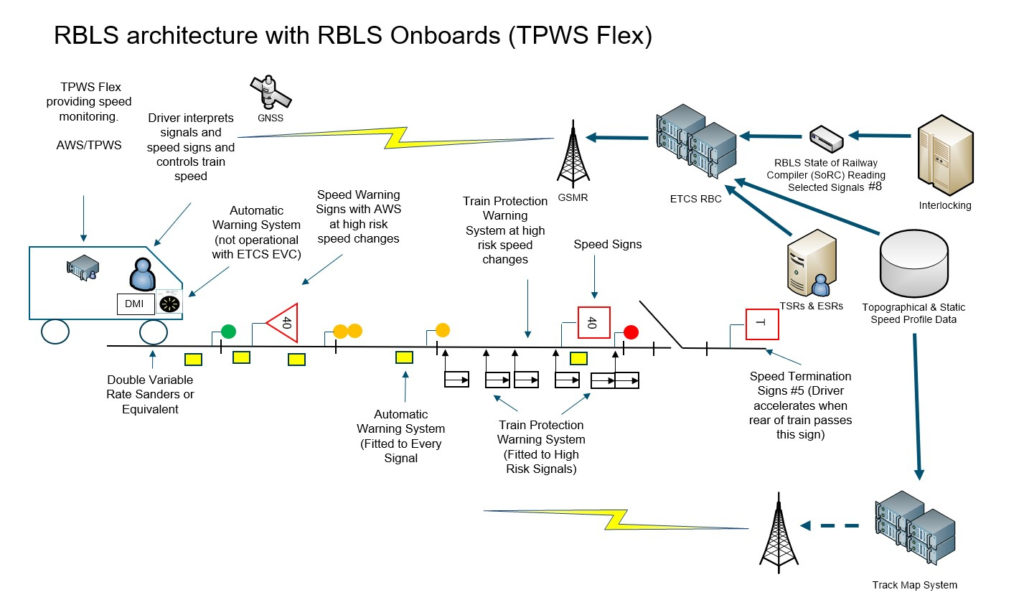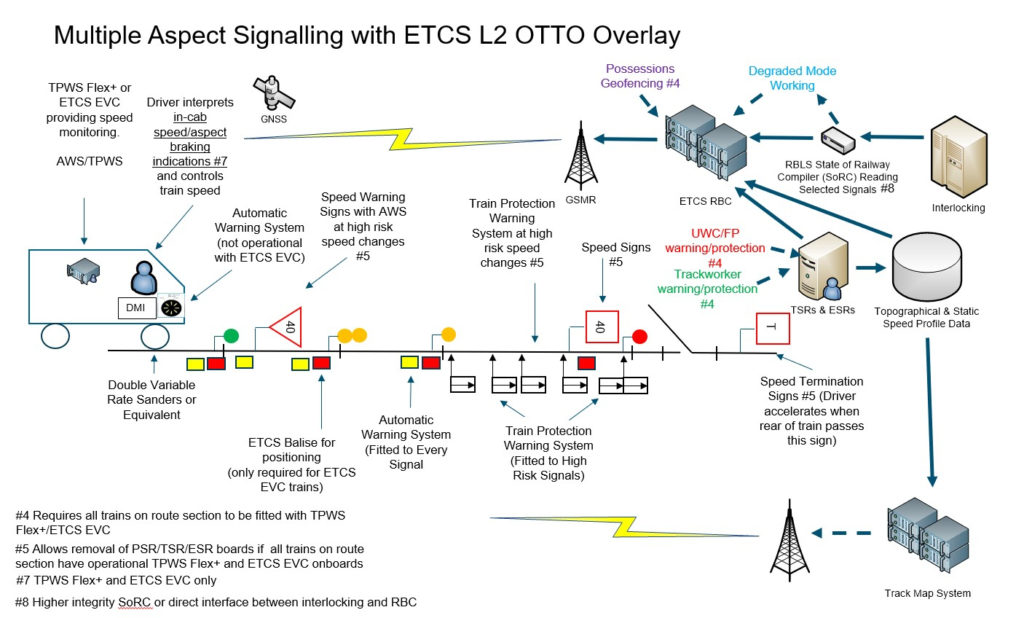One of the features and benefits of rail is the very energy efficient, low friction, steel wheel on steel rail interface. This does however mean it is difficult to stop a train, especially within the distance a driver can see ahead, resulting in the need for railway signalling and, in particular, train warning and protection systems.
The latest initiative by Network Rail is Radio Based Limited Supervision (RBLS). RBLS will supplement the Automatic Warning System (AWS) and Train Protection and Warning System (TPWS), until fully Automatic train Protection (ATP) via European Train Control System (ETCS) is rolled out.
For many years, AWS has been provided to warn drivers of caution and stop signals. AWS gives a warning that the associated signal is not green and applies the brakes if the driver doesn’t acknowledge the warning. A drawback with AWS, however, is that there is no distinction between stop and caution signals. Drivers running on consecutive ‘double yellows’ receive a series of warnings, which can make cancelling the warning an automatic reaction without acknowledging the signal aspect.
Clapham Junction
Following the Clapham Junction train crash in 1988, one of the recommendations was to provide ATP throughout the GB network. ATP systems take into account the state of the signals, speed restrictions, and gradients, and constantly supervise train speed, intervening if the driver attempts to drive faster than the safe speed. British Rail instigated trials of two systems on the Chiltern Line and on the Great Western route between London and Bristol. However, it was established that the cost and benefits of fitting ATP to the national network could not be justified.
Signals past at danger (SPADs) were still a serious safety hazard however, and so the Signals Passed At Danger Reduction And Mitigation (SPADRAM) project was set up. It was identified that most SPADs were caused by drivers leaving it too late to brake and passed the signal by a short distance. These usually have no consequence, as signalling design considers the possibility that a train may not stop where it should, and signals are sited with a protective ‘overlap’ before the fouling point.
The relatively simple and cost-effective TPWS was therefore developed to instigate a brake activation and to mitigate the consequences of a SPAD. Signals protecting junctions would be fitted with a train stop and speed controls. So, if a train was approaching a stop signal at an excessive speed, TPWS would react with an emergency brake application.

Limitations
TPWS has been a great success in reducing and mitigating SPADs. The lower cost and simplicity of TPWS meant that nationwide implementation was more rapid than nationwide roll out of ATP would have been, and TPWS has prevented incidents which would probably have had consequences similar to Ladbroke Grove. However, TPWS does not cover all driver errors.
The purpose of TPWS, where TPWS track equipment is fitted, is to automatically initiate a brake demand, if the train has: (i) passed a signal at danger without authority; (ii) approached a signal at danger too fast; (iii) approached a reduction in permissible speed too fast; or (iv) has approached buffer stops too fast.
A TPWS installation consists of an on-track transmitter adjacent to a signal, activated when the signal is at danger. A train that passes the signal will have its emergency brake activated. If the train is travelling at speed, this may be too late to stop it before the point of collision, therefore a second transmitter may be placed on the approach to the signal that applies the brakes on trains going too quickly approaching the signal at danger. This is positioned to stop the majority of trains approaching at up to 75mph (120km/h).
The train protection risk reduction capability of TPWS has proven to be higher than originally envisaged, but the residual risk considerations between the capability of TPWS and ATP (ETCS) include that not all signals are fitted with TPWS and not all trains are able to be stopped before the conflict point, even at fitted signals. Not all Permanent Speed Restrictions (PSRs) – including lower speed turnouts – are protected with TPWS and the protection arrangements are limited. Temporary and Emergency Speed Restrictions (TSRs and ESRs) are also not fitted with TPWS and TPWS is not a failsafe design system. It was always intended as an interim arrangement until ETCS with ATP was provided.
RBLS
The need for RBLS was prompted in 2019 around the time of the anniversary of the Ladbroke Grove crash, when two passenger trains collided almost head-on after one of them had passed a signal at danger. RBLS centres on the train protection residual safety risks between TPWS and ATP delivered by ETCS.
Currently, the roll-out of ETCS is extended to that envisaged when the strategy of TPWS as an interim train protection strategy was adopted. The GB Long Term Deployment Plan also highlights that TPWS will still be operational on some routes in 40 years’ time. So, it was identified that a way was required for the GB rail system to manage the identified train protection residual risk, So Far As Is Reasonably Practicable (SFAIRP), prior to the full roll out ETCS ATP. The result was RBLS.
RBLS cab indications will provide updates of signal status to ensure speed supervision profiles are at all times aligned with signal aspects and are such that the infrastructure safety envelope is not exceeded. RBLS will also allow trains with higher braking capabilities to pass double yellow signals and delay braking – improving signalling headways with no repetitive AWS cancellations.
The RBLS architecture could use ETCS onboard systems or a specific RBLS onboard system for fleets not envisaged to be fitted with ETCS onboard – these could use Global Navigation Satellite System (GNSS) with other measures for their positional reference. In addition, the architecture could include ETCS Radio Block Centre (RBC) with RBLS capability, TSR and ESR data, and topographical and static speed profile data – which for the specific RBLS onboard solution using GNSS, would be downloaded to the train by a Track Map system.

OTTO
The Optimised Train Track Operations (OTTO) concept is a set of systems and railway configurations derived from the RBLS concept that have the potential to deliver safety, operational efficiencies, and performance benefits, linked to business needs of the existing network ahead of ETCS deployment.
The OTTO concept has the potential to address safety issues faster than is possible through ETCS deployment. These safety issues include: overspeed, track worker, possession management, and level crossing (footpath and user worked crossing). OTTO also has the potential to provide SPAD mitigations and performance benefits with the braking capability of trains maximised, resulting in less restrictive aspects, which is also a safety benefit. The OTTO concept will be modular in design such that the system configuration can be aligned to the business needs of a route section/train operator and will consist of a number of systems/configurations:
Speed Restriction Management System (permanent/ temporary/emergency) to facilitate the application of ‘zero speed restrictions’ required for track worker protection, possessions management system, and level crossing management.
TPWS Flex+ (RBLS specific onboard with Driver Machine Interface – DMI). This will use GNSS geospatial positioning to provide autonomous vehicle location (similar to a car SATNAV). Information will be provided to the driver of the speed restrictions applicable or approaching and will continuously monitor the train speed and automatically apply the train brakes if going too fast.
Isolated Speed Limited Authority (ISLA) – enhanced RBLS train positioning system. This will be independent of the signalling system and will consist of a Track Map server to provide the speed information to the TPWS Flex+ system. It will connect to Network Rail’s Network Model (Axiom) to provide topographical information and to the speed restriction management system for information on speed restrictions.
OTTO Overlay (RBLS state of railway compiler) – will provide ETCS functionality that can be interpreted by TPWS Flex+ (and ETCS) fitted trains. It will connect to the signalling system by a simple interface and facilitates SPAD protection plus speed limit control for diverging routes. The OTTO overlay also improves SPAD management by ensuring that all trains will be able to stop before conflict points.
The business case
The initial business and safety analysis has concluded that OTTO has the potential for extracting business benefits (including safety benefits) to GB rail if all trains are retrofitted with TPWS Flex+ and the majority of infrastructure with ISLA, and to fit ETCS Level 2 with no signals for all conventional signalling renewals when all trains on the route section are fitted with TPWS Flex+ or ETCS.
The technologies associated with OTTO are still at concept and early development phases. The full benefits will not be realised until at least the end of Control Period 7 (2029) and need to be aligned with TPWS Flex+ fitment.
The OTTO strategy has the potential to be the ALARP solution for the migration to ETCS based on the early system benefits associated with the ISLA/TPWS Flex+ configuration, therefore further development activities including ALARP safety analysis and more detailed business analysis, and operational trials are being undertaken. However, until such time as OTTO can demonstrate maturity on an operational railway, the base case is to maintain the current ETCS programme supporting the Control Period 7 and 8 renewal plans (2024-2034).
Many thanks to Andrew Simmons, Head of System Authority Network Rail for his assistance with this article.
Image credit: istockphoto.com / Network Rail

